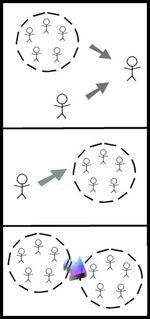 Social psychological work can not be approached with the interests and the emphases of both psychology and sociology in mind. As a result, the discipline can be split into at least two general subfields, which concentrate on the relative importance of some subjects over others. (House, 1977)
Social psychological work can not be approached with the interests and the emphases of both psychology and sociology in mind. As a result, the discipline can be split into at least two general subfields, which concentrate on the relative importance of some subjects over others. (House, 1977)
Relation to other fields Edit
Social psychology has close ties with the other social sciences, especially sociology and psychology. It also has very strong ties to the field of social philosophy.
Sociology is the study of group behavior and human societies, with emphasis on the structures of societies and the processes of social influence. Includes all organizational behavior.
Psychology is the study of the underlying psychological processes that make all behaviors and experiences possible. Some examples of the things it seeks to explain are: the attribution of mental states to others, the notion of a unitary 'self', sight and perception, personality and identity, warfare and violence, love, being hungry, waking up, etc.
Philosophy of the social sciences is the study of theoretical questions about the experience and behavior of persons and the justifications involved with how they are studied in the social sciences. It involves questions related to the philosophy of mind, the philosophy of language, social epistemology, and many other fields.General research interests Edit
Social psychology attempts to understand the relationship between minds, groups, and behaviors in three general ways.
First, it tries to see how the thoughts, feelings and behaviors of individuals are influenced by the actual, imagined, or implied presence of other(s) (Allport 3). This includes social perception, social interaction, and the many kinds of social influence (like trust, power, and persuasion). Gaining insight into the social psychology of persons involves looking at the influences that individuals have on the beliefs, attitudes, and behaviors of other individuals, as well as the influence that groups have on individuals. This aspect of social psychology asks questions like:
* How do small group dynamics impact cognition and emotional states?
How do social groups control or contribute to behavior, emotion, or attitudes of the individual members?
How does the group impact the individual?
How does the individual operate within the social group?
Second, it tries to understand the influence that individual perceptions and behaviors have upon the behavior of groups. This includes looking at things like group productivity in the workplace and group decision making. It looks at questions like: * How does persuasion work to change group behavior, emotion or attitudes?
What are the reasons behind conformity, diversity, and deviance?
Third, and finally, social psychology tries to understand
groups themselves as behavioral entities, and the relationships and influences that one group has upon another group (Michener 5). It asks questions like: * What makes some groups hostile to one another, and others neutral or civil?
Do groups behave in a different way than an individual outside the group?
In European textbooks there is also fourth level called the "ideological" level. It studies the societal forces that influence the human psyche.
Specific research interests Edit
The scope of social psychological research. Based on input from Cote and Levine, 2002.
Some of the basic topics of interest in social psychology are:
- which investigates the cognitive processes underlying the way we form impressions of others. This includes the biases guiding our impressions, the inferences we make, and the weight we give to different pieces of information.
- which investigates the cognitive processes underlying our beliefs about the social world. Some of the heuristics or “rules of thumb” include the availability heuristic, representativeness heuristic, and anchoring and adjustment. We are sometimes also biased toward over-attributing our own personal beliefs to society at large, i.e. the false consensus effect. Some people also tend to believe in a just world which can lead to blaming the victim in some circumstances.
– The focus of this area is the study of the relationship between attitudes and behavior and the use of persuasive communication to change attitudes. The primary theories used to explain and predict the relationship between attitudes and behavior are the theories of reasoned action (Ajzen & Fishbein, 1980) and planned behavior (Ajzen, 1985). The primary theory of attitude change is the Elaboration Likelihood Model (Petty & Caccioppo, 1986).
- This area of research studies the methods people use to make us comply, conform, or obey their authority. Social Impact Theory is the most heavily used theory in this area (Latane, 1981).
- includes the study of group formation, effectiveness and influences on the individual.
Close Relationships - Social Psychologists in this area study the processes underlying relationship formation, maintenance and dissolution. Prominent theories in this area are Interdependence Theory (Rusbult, Agnew & Arriaga, 2001) and Attachment Theory (Reis & Patrick, 1996).
Pro-social behavior - Social Psychologists in this area study the factors that influence helping behavior.
Intergroup Relations - which studies prejudice and discrimination.
(which investigates the learning of standards, rules, attitudes, roles, values, and beliefs; and the agents, processes, and outcomes of learning) and (which looks at the contribution of both nature and nurture in production of social behavior).
- the effects of role schemas on the perceived makeup of gender and the sexes
and life course - the general facets of life in various societies, including personal careers, identities, biological development, and shifts in roles
- the development (in stages) of the rational and social-psychological abilities required to make moral judgments. See Lawrence Kohlberg
(which delves into the learning and processing of verbal and non-verbal language, and the effects of social structures and societies on the use of both).Basic considerations Edit
Social psychologists use a wide range of research methods; depending on the research questions.
There are several important issues to consider when setting up research, among which the essential questions:
- Is the research question exploratory (gathering information in order to build a theory) or confirmatory (gathering information in order to confirm a theory)?
- How important is experimental control (internal validity) compared to being able to generalise results to a naturalistic situation for the population at large (external validity)?
Based on considerations above, the type of research (qualitative, or quantitative) and the exact methods, theories and statistical analyses are chosen.
Methods Edit
Social psychologists make use of both qualitative and quantitative methodologies.
Quantitative methods include surveys, controlled experiments, and mathematical modeling, with some emphasis upon correlational research.
As it is impossible to test every person in a population research is conducted on a sample of persons from a wider population. Social psychologists typically use random assignment of participants and a control group that resembles the experimental groups in all respects other than the independent variable. When experiments take this form, it tends to mitigate the effects of potential confounds.
Social psychologists rely often on experimentation. Controlled experimentation requires the manipulation of one or more independent variables in order to examine its effect on a dependent variable. Also required is the experimental control of potential confounding influences, known as extraneous variables. Controlled experiments are attractive for use in social psychology because they are high in internal validity, meaning that they are free from the influence of extraneous variables, and so are more likely to accurately indicate a causal relationship. However, the small samples used in controlled experiments are low in external validity, or the degree to which the results can be generalized the larger population.

 Social psychological work can not be approached with the interests and the emphases of both psychology and sociology in mind. As a result, the discipline can be split into at least two general subfields, which concentrate on the relative importance of some subjects over others. (House, 1977)
Social psychological work can not be approached with the interests and the emphases of both psychology and sociology in mind. As a result, the discipline can be split into at least two general subfields, which concentrate on the relative importance of some subjects over others. (House, 1977)












